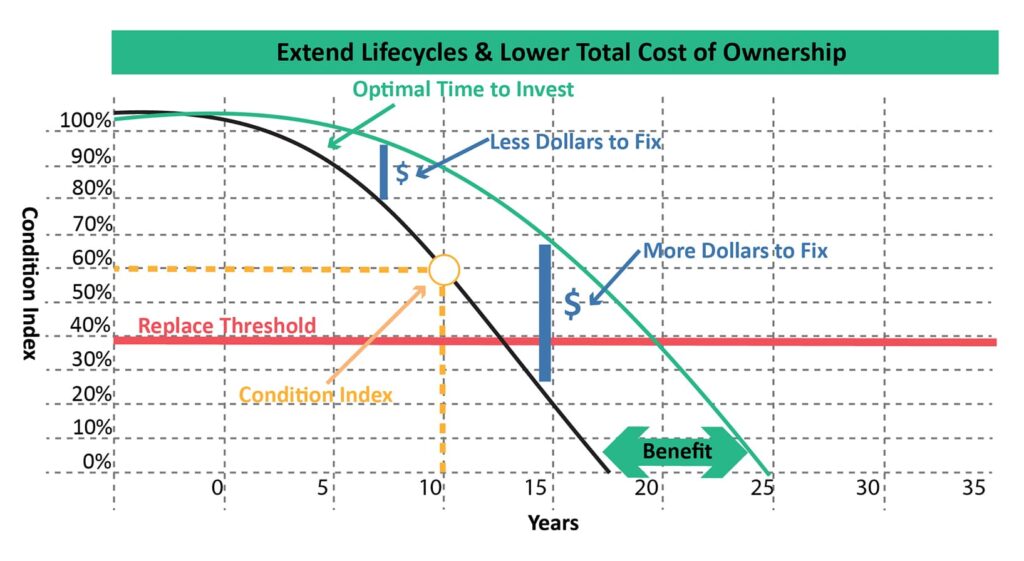There are four (4) major facility asset management metrics that need to be understood and managed when implementing a roof asset management program. By using IFMA, APPA and ASTM standards within the structure of a roof program, it affords you consistent findings and reporting.
It should also be noted that the same critical facility asset management metrics can be extended to more than just roof asset management programs. The same standards apply to multiple building systems per building or across the portfolio, i.e. vertical facade systems, pavements, parking garages, HVAC, lighting, etc.
Condition Index (CI)
Each individual system unit, area or section needs to have a condition rating that is objectively measured. This is calculated by the age of the system, and the type, severity and quantity of defects assessed, divided into the roof replacement cost plus known historical costs (if any) and a roof weighted age factor.
For whole building or entire facility asset management programs, the system unit CI can be rolled up to a building, site or portfolio wide SCI (system condition index), i.e. all roofs or all HVAC systems per building, site or across the portfolio. The SCIs are then rolled up to a building, facility or entire portfolio FCI (facility condition index).
Useful Life
Every roof system should have a known service life and every building type should have a defined service life. There are three (3) main useful life metrics that can be calculated:
Service Life (SL): The average service life of a roof system, which is based up on national averages.
Total Service Life (TSL): This is based off the year built/installed to the projected replacement.
Remaining Service Life (RSL): This is based upon the system or section’s objective condition index (CI).
Each of these can be further measured depending on if repair and/or preventative maintenance efforts are incorporated into the asset management program.
Roofs, HVAC, elevators, pavements, lighting, interior finishes, etc. typically have numerous capital renewals/replacements over the total service life of a facility or building. The introduction of sustainable defect repair upgrades and preventative/predictive maintenance programs can greatly impact the remaining service life of the major system groups. The implementation of sustainable programs can extend the life of these assets, reduce emergency spend and minimize the frequency of capital renewals.
Total Cost of Ownership (TCO)
Every building system and every building type has a total cost of ownership (TCO) that can be assigned to it. The TCO should include all costs of a building system or complete facility, from cradle to grave. The TCO metric can be used to determine and compare the overall lifecycle costs of a specific facility type or major system group prior to purchase, and/or be used to evaluate different life extension programs that can lower the overall TCO of a major system group or entire facility.
Triage Score¹
Triage is a French word meaning sorting. The triage score uses at least two performance metrics: The mission dependency index (MDI) ranking of buildings and the condition index (CI) referenced above. The mission criticality of a building is weighted higher than its condition – about 60/40. Triage scores are further ranked by the amount of years over the systems’ service life (SL). Roofs furthest beyond their service life are ranked highest.
The triage score provides an unbiased solution to the complex problem of ranking and prioritizing capital and repair projects. The triage score process also can be used to screen out projects that should be deferred if they have little or no relevance to an organization’s mission. Project prioritization can be performed with or without budget constraints.
The MDI supports and is consistent with all federal facility asset management principles. It has been recognized and endorsed by the General Services Administration, the National Academy of Sciences (NAS) National Research Council and the Federal Facilities Council, as well as the Association of Higher Education Facility Officers (now known as APPA). The Triage Score was originally introduced by Albert Antelman, RA and James B. Clayton, PE.
¹The Triage Facility Management Triage for Quick & Credible Repair/Replace Funding Decisions

